Climate Change In India
Sep 24, 2019 • 547 views
Circumstances
As indicated by India, A "minor choice of the UN General Council" to assume control over authorization of climate change activity would disturb the Paris Agreement and multilateral endeavors to discover solutions.
Climate change is a worldwide risk to security in the 21st century. We should act presently to restrain future dangers to the planet we share and the harmony we look for
Factor influencing Climate Change
Both normal and anthropogenic elements can cause changes in Earth's Energy cycle.

Factors Affecting Climate Change Source: Research Gate
Natural Factors
The Earth's climate can be influenced by various natural elements. The widespread ones are mainland drift, volcanoes, ocean flows, Earth's tilt, and comets and shooting stars. The regular variables influence the climate change in a long haul and continue for thousand to a huge number of years.
Mainland Drift
Mainland float additionally affected the climate since it changed the physical characteristics of the landmass, their position and the situation of water bodies like changed the progression of sea flows and winds, which influenced the climate. The drift procedure is as yet proceeded with today, the Himalayan range is ascending by around 1 mm consistently in light of the fact that the Indian land mass is moving towards the Asian landmass, gradually however relentlessly.
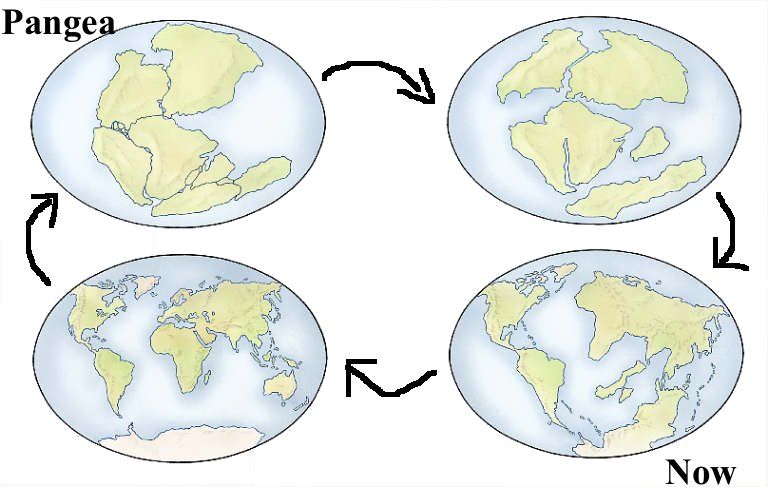
Continental Drift Source: Illinois
Variety in the Plants Orbit
A slight variety in Earth's circle prompts variety in the dispersion of daylight over the globe.
There are three sorts of orbital varieties to be specific varieties in Earth's whimsy, changes in the tilt edge of Earth's axis of turn and precession of Earth's axis Combined together, these produce Milankovitch cycles which have a huge effect on climate and are striking for their relationship to frosty and interglacial periods.
Plate tectonics
The situation of the mainland impacts examples of ocean dissemination as it decides the geometry of the oceans. The areas of the oceans are significant in controlling the exchange of warmth and dampness over the globe, and along these lines, in deciding worldwide climate.
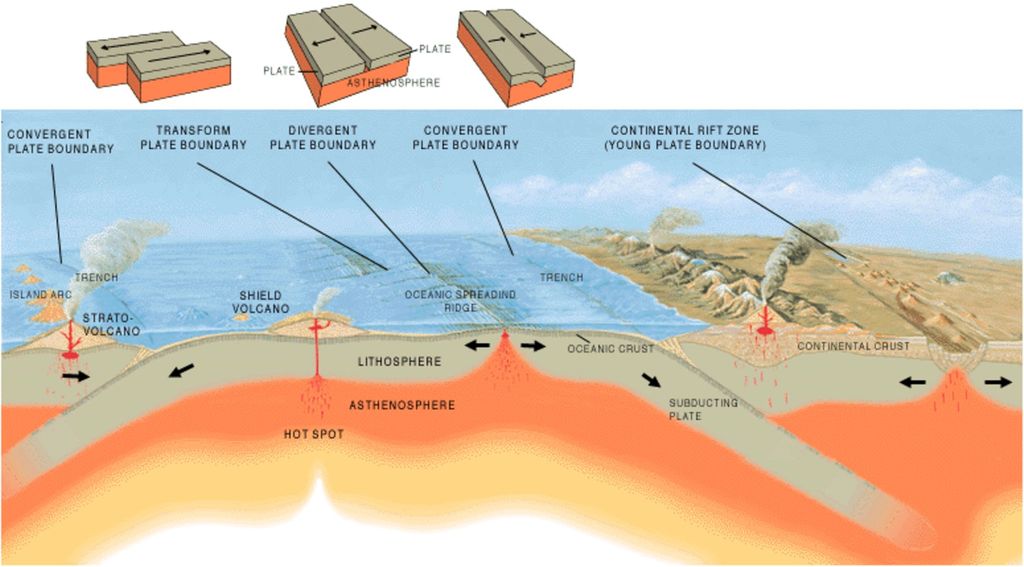
Plate Tectonic Source: The Conversation
Volcanic movement
In spite of the fact that the volcanic movement may last just a couple of days yet the huge volumes of gases and fiery debris can impact the climatic example over the quite a long while.
Ocean flows
Because of temperature variety of the water, the climate of the area concerned is generally affected. On longer time scales, adjustments to ocean procedures, for example, thermohaline dissemination assume a key job in redistributing heat via doing a moderate and very profound movement of water, and the long haul redistribution of warmth on the planet's sea.
Anthropogenic (Human Caused) Factors
Anthropogenic or synthetic components bring about transient climatic changes. Researchers have been watching a change in the climate since the start of the twentieth Century that can't be credited to any of the 'regular' impacts of the past.
Reason for anthropogenic (human caused) climate change incorporates ozone depleting substances, aerosols concentration and example of land use changes.
Ozone depleting substances
The Earth is enriched with a characteristic nursery impact where certain gases (known as ozone harming substances) in the climate grant the daylight to enter however ingest or absorb the warmth radiation. They keep the normal surface temperature on Earth around 14°C. Without the normal nursery impact, the Earth's average surface temperature would be near - 19°C.
As the human movement has expanded because of beginning of Industrial transformation, the discharge of gigantic measure of GreenHouse Gases is likewise expanded which prompted more ingestion of warmth being held in the climate in this manner an expansion in worldwide Temperature was observed. Greenhouse gases while to a great extent straightforward to approaching sun based radiation, retains a large portion of the infrared transmitted by the world's surface.

Greenhouse Effect Source: Geology Learn Blogspot
Atmospheric Aerosols
Atmospheric Aerosols concentration influence climate in two significant ways:
• they cause dispersing and engrossing the sun based infrared radiation
• they change the microphysical and compound properties of mists and conceivably their lifetime and degree
The dissipating of sun powered radiation cools the planet, while retention of sun based radiation by vaporizers act to warm the air legitimately as opposed to enabling daylight to be consumed by the outside of the Earth. Aerosols can impact climate straightforwardly by engrossing or reflecting approaching sun based radiation, however they can likewise deliver backhanded consequences for climate by altering cloud arrangement or cloud properties. Mist concentrates can be shipped a huge number of kilometers from the wellsprings of inception by winds and upper level dissemination in the air.
Land Use changes
Chopping down trees to make farmland prompted changes in the measure of daylight reflected starting from the ground stage into space (the surface albedo). About portion of the land use changes are evaluated to have happened during the modern time, a lot of it because of substitution of backwoods by horticultural trimming and touching terrains over Eurasia and North America. High Latitudes areas are to a great extent influenced because of deforestation as the albedo of snow-secured land, recently forested, has expanded. This is on the grounds that snow on trees reflects just about portion of the daylight falling on it, while snow-made open progress reflects around 66%. By and large, the expanded albedo over Eurasian and North American agrarian districts has had a cooling impact.
Breaking down the surface records of changing land use with satellite estimations of the properties of vegetation spread demonstrate that woodland clearing for agribusiness and watered cultivating in parched and semi-bone-dry grounds are two noteworthy wellsprings of climatically significant land spread changes. The two impacts in any case, to offset, in light of the fact that watered agribusiness increments sun oriented energy ingestion and the measure of dampness dissipated into the air, while backwoods clearing diminishes these two procedures.
Proof For Rapid Climate Change
Worldwide Temperature Rise:
The planet's normal surface temperature has ascended about 1.62 degrees Fahrenheit (0.9 degrees Celsius) since the late nineteenth century, a change driven to a great extent by expanded carbon dioxide and other human-made outflows into the air. The majority of the warming happened in the previous 35 years, with the five hottest years on record occurring since 2010.
Warming Oceans:
The seas have consumed a lot of this expanded warmth, with the best 700 meters (around 2,300 feet) of sea indicating warming of more than 0.4 degrees Fahrenheit since 1969.
Contracting Ice Sheets:
The Greenland and Antarctic ice sheets have diminished in mass. Information from NASA's Gravity Recovery and Climate Experiment show Greenland lost a normal of 286 billion tons of ice for every year somewhere in the range of 1993 and 2016, while Antarctica lost around 127 billion tons of ice for every year during a similar timespan. The pace of Antarctica ice mass misfortune has significantly increased in the most recent decade.
Glacial Retreat:
Glaciers are withdrawing wherever around the globe — incorporating into the Alps, Himalayas, Andes, Rockies, Alaska and Africa.
Diminished Snow Cover:
Satellite perceptions uncover that the measure of spring snow spread in the Northern Hemisphere has diminished in the course of recent decades and that the snow is softening prior.
Ocean Level Rise:
Global ocean level rose around 8 crawls in the recent century. The rate over the most recent two decades, nonetheless, is about twofold that of the only remaining century and is quickening somewhat consistently.
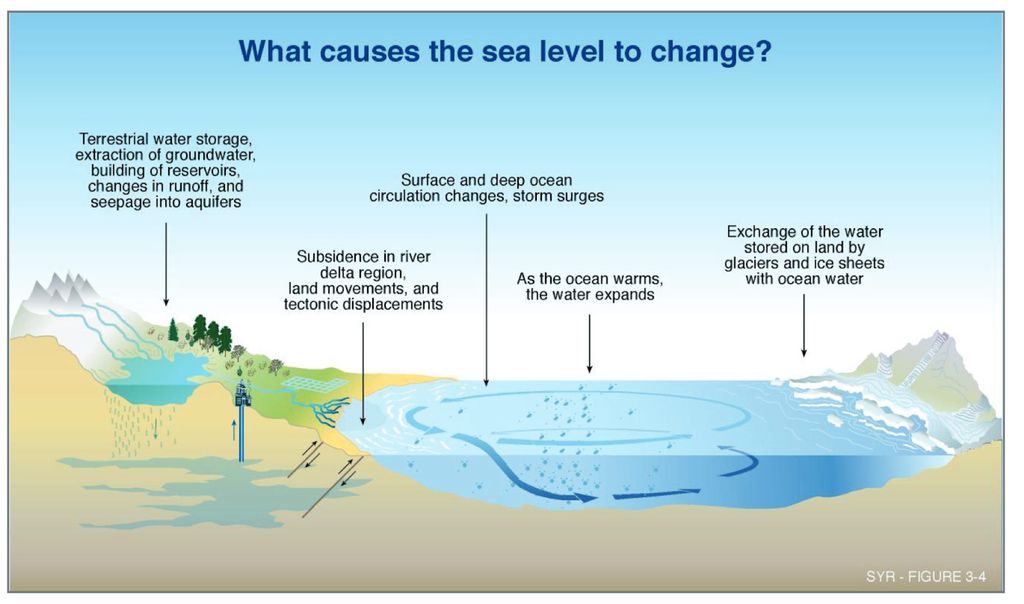
Sea Level Change Source: Circa Education
Declining Arctic Ocean Ice:
Both the degree and thickness of Arctic ocean ice has declined quickly throughout the most recent quite a few years.
Extraordinary Events:
The quantity of record high-temperature occasions in the United States has been expanding, while the quantity of record low-temperature occasions has been diminishing, since 1950. The U.S. has likewise seen expanding quantities of extreme precipitation occasions.
Acidification of Oceans:
Since the start of the Industrial Revolution, the corrosiveness of surface sea waters has expanded by around 30 percent. This expansion is the consequence of people producing more carbon dioxide into the environment and consequently all the more being consumed into the seas. The measure of carbon dioxide consumed by the upper layer of the seas is expanding by around 2 billion tons each year.
"A New Climate for Peace: Taking Action on Climate and Fragility Risks", an autonomous report presented by individuals from the G7, recognizes seven compound climate-delicacy chances that posture genuine dangers to the steadiness of states and social orders in the decades ahead:
Proximate Asset Rivalry:
As the weight on regular assets expands, rivalry can prompt insecurity and even savage clash without viable contest goals.
Livelihood instability and Forced Migration:
Climate changes will agonize the human weakness of individuals who rely upon regular assets for their occupations, which could push them to move or go to unlawful wellsprings of pay.
Extraordinary climate occasions and catastrophes:
Extreme climate occasions and calamities will worsen delicacy challenges and can expand individuals' defenselessness and complaints, particularly in strife influenced circumstances.
Unpredictable sustenance costs and arrangement:
Climate change is almost certain to disturb nourishment creation in numerous locales, expanding costs and market unpredictability, and increasing the danger of challenges, revolting, and common clash.
Transboundary water Execution:
Transboundary waters are every now and again a wellspring of strain; as interest develops and climate effects influence accessibility and quality, rivalry over water use will probably press existing administration structures.
Ocean level ascent and beach front debasement:
Rising ocean levels will undermine the feasibility of low lying territories even before they are submerged, prompting social interruption, removal, and movement, while contradictions over sea limits and sea assets may increment.
Unintended impacts of climate change
Approach Analysis: The Need for an Integrated Agenda
The most ideal approach to lessen the danger presented by these climate-delicacy dangers is to alleviate climate change. In any case, changes to the climate are as of now in progress, so we should find a way to oversee and limit these dangers today. To separate the sectoral obstructions that hamper endeavors to address climate-delicacy dangers, we have to address key approach and institutional holes in three zones:
Climate change adjustment:
programs help nations envision the unfriendly impacts of climate change and make a move to avoid, limit, and react to their potential effects.
Advancement and compassionate guide projects
help states and populaces assemble their financial, administration, and social limits and improve their strength to stuns.
Harmony building and struggle counteractive action projects
address the circumstances and end results of delicacy and strife by lessening strains and making a situation for practical harmony.
For what reason is climate change significant to India?
India is among the most defenseless nations against climate change. It has perhaps the most elevated density of economic transactions on the planet, and exceptionally huge quantities of destitute individuals who depend on the common asset base for their vocations, with a high reliance on precipitation. By 2020, weight on India's water, air, soil, and woods is relied upon to turn into the most astounding on the planet.
One of the most noteworthy ways that climate change will affect the lives of individuals in India will be through its water assets. While water supports life, it very frequently unleashes ruin through annihilating floods and dry spells. A changing climate will just exasperate these stuns.
Potential Effects of climate change in India
Extraordinary Heat:
India is as of now encountering a warming climate. Abnormal and remarkable spells of sweltering climate are relied upon to happen unmistakably more every now and again and spread a lot bigger territories. Under 4°C warming, the west coast and southern India are anticipated to move to new, high-temperature climatic systems with critical effects on agribusiness.
Changing Rainfall Patterns:
A decrease in storm precipitation since the 1950s has just been watched. A 2°C ascent on the planet's normal temperatures will make India's late spring rainstorm profoundly capricious. At 4°C warming, a very wet storm that at present gets an opportunity of happening just once in 100 years is anticipated to happen at regular intervals before the century's over. Dry years are relied upon to be drier and wet years wetter.
Dry spells:
Evidence shows that pieces of South Asia have turned out to be drier since the 1970s with an expansion in the quantity of dry seasons. Dry spells have real results. In 1987 and 2002-2003, dry spells influenced the greater part of India's harvest region and prompted a gigantic fall in yield creation. Dry seasons are relied upon to be progressively visit in certain territories, particularly in north-western India, Jharkhand, Orissa and Chhattisgarh. Harvest yields are relied upon to fall essentially as a result of outrageous warmth by the 2040s.
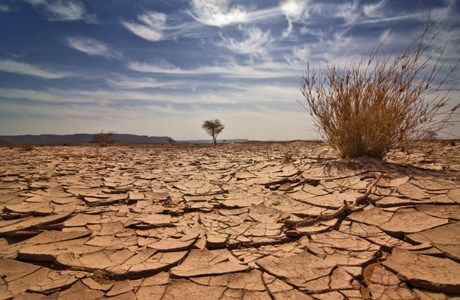
Dry Spells Source: Crunk Feminist Collective
Groundwater:
Even without climate change, 15% of India's groundwater assets are overexploited. Falling water tables can be relied upon to decrease further by virtue of expanding interest for water from a developing populace, progressively princely ways of life, just as from the administration's division and industry.
Ice sheet Melt:
Most Himalayan icy masses have been withdrawing over the previous century. At 2.5°C warming, dissolving ice sheets and the loss of snow spread over the Himalayas are required to undermine the security and unwavering quality of northern India's principally ice sheet encouraged streams. Changes in the progressions of the Indus, Ganges, and Brahmaputra waterways could altogether affect water system, influencing the measure of sustenance that can be created in their bowls just as the jobs of a large number of individuals
Ocean level ascent:
With India near the equator, the sub-mainland would see a lot higher ascents in ocean levels than higher scopes. Ocean level ascent and tempest floods would prompt saltwater interruption in the beachfront zones, affecting farming, debasing groundwater quality, sullying drinking water, and conceivably causing an ascent in the runs cases and cholera episodes, as the cholera bacterium endures longer in saline water. Kolkata and Mumbai, both thickly populated urban communities, are especially defenseless against the effects of ocean level ascent, tropical violent winds, and riverine flooding.
Aside from this nourishment and energy security are additionally real concerns. Water shortage, wellbeing dangers among the majority and movement and political clashes are required to develop.
India's reaction to Climate Change
National Action Plan on Climate Change (NAPCC):
diagrams existing and future arrangements and projects tending to climate relief and adjustment. The Action Plan recognizes eight center "national missions" going through to 2017: Solar Energy; Enhanced Energy Efficiency; Sustainable Habitat; Water; Sustaining the Himalayan Eco-framework; Green India; Sustainable Agriculture; and Strategic Knowledge for Climate Change. The greater part of these missions have solid adjustment objectives.
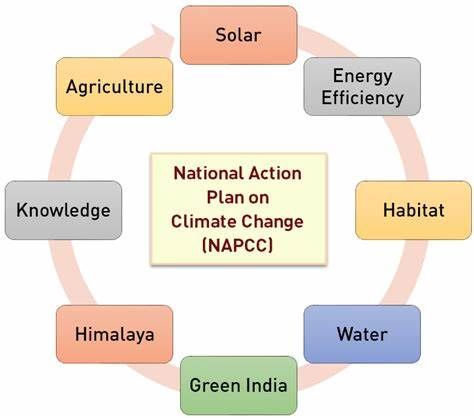
NAPCC Source: Mrunal
National Clean Energy Fund:
The Government of India made the National Clean Energy Fund (NCEF) in 2010 to back and advancing clean vitality activities and subsidizing research in the territory of clean vitality in the nation. The corpus of the store is worked by collecting a cess of INR 50 (hence expanded to INR 100 of every 2014) per ton of coal delivered locally or imported.
Paris Agreement:
Under the Paris Agreement, India has made three duties. India's ozone depleting substance emanation power of its GDP will be decreased by 33-35% beneath 2005 levels by 2030. Close by, 40% of India's capacity limit would be founded on non-petroleum product sources. Simultaneously, India will make an extra 'carbon sink' of 2.5 to 3 billion tons of Co2 equal through extra woodland and tree spread by 2030.
Global Solar Alliance:
ISA was propelled at the United Nations Climate Change Conference in Paris on 30 November 2015 by India and France, within the sight of Mr. Ban Ki Moon, previous Secretary-General of the United Nations.
Bharat Stage (BS) Emission Norms:
Emissions from vehicles are one of the top supporters of air contamination, which drove the legislature at an opportunity to present the BS 2000 (Bharat Stage 1) vehicle discharge standards from April 2000, trailed by BS II in 2005. BS III was executed across the nation in 2010. In any case, in 2016, the administration chose to meet the worldwide prescribed procedures and jump to BS-VI standards by skipping BS V out and out.
Every one of these endeavors need to execute well to moderate the impacts of climate change.
To Conclude
We don't have the choice in India of considering whatever is guiltless of climate change any longer.
We should perceive climate change as a worldwide aggregate activity issue.
On the off chance that one nation slices its discharges deep down, that will be of little use if the others don't go with the same pattern. They will endure the results of climate change regardless of the degree of their penance or exertion.
We have to move climate change, an Earth-wide temperature boost to the highest point of our international strategy plan.
This is a basic move we have to make and the sooner we do it, the more noteworthy is the advantage that we will draw from our very own climate activities.
What's more, India will most likely surpass the NDC(Nationally Determined Contributions) vows, on the grounds that for reasons like urban clog and air contamination, we will need to move toward low carbon in any case, very separated from climate change.
